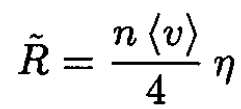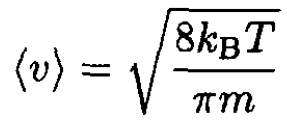
Hydrogen Sublimation in Intergalactic Space
 المؤلف:
Sidney B. Cahn, Gerald D. Mahan And Boris E. Nadgorny
المؤلف:
Sidney B. Cahn, Gerald D. Mahan And Boris E. Nadgorny
 المصدر:
A GUIDE TO PHYSICS PROBLEMS
المصدر:
A GUIDE TO PHYSICS PROBLEMS
 الجزء والصفحة:
part 2 , p 30
الجزء والصفحة:
part 2 , p 30
 29-8-2016
29-8-2016
 1543
1543
Hydrogen Sublimation in Intergalactic Space
A lump of condensed molecular hydrogen in intergalactic space would tend to sublimate (evaporate) because the ambient pressure of hydrogen is well below the equilibrium vapor pressure. Find an order-of-magnitude estimate of the rate of sublimation per unit area at T = 3K. The latent heat of sublimation is L ~ 450 J/g, and the vapor pressure at the triple point Tt ~ 15 K is Pt ~ 50 nm of Hg. (1 atm ~760 nm Hg ~ 106 dyn/cm2).
SOLUTION
We can estimate the vapor pressure P at T = 3K. Namely,
 (1)
(1)
where Pt is the pressure at the triple point and R is the gas constant. Here we disregard the volume per molecule of solid hydrogen compared to the one for its vapor. This formula is written under the assumption that the latent heat does not depend on the temperature, but for an order-of-magnitude estimate this is good enough.
Consider solid hydrogen at equilibrium with its vapor. Then the number of particles evaporating from the surface equals the number of particles striking the surface and sticking to it from the vapor. The rate  of the particles striking the surface is given by
of the particles striking the surface is given by
 (2)
(2)
where ρ is the number density, ⟨v⟩ is the average speed, and η is a sticking coefficient, which for this estimate we take equal to 1. Where we calculated the rate of particles striking the surface. Now if the density is not too high, the number of particles leaving the surface does not depend on whether there is vapor outside, so this would be the sublimation rate. we get

where m is the mass of a hydrogen molecule, and substituting n = P/kBT, we may rewrite (2) as
 (3)
(3)
 الاكثر قراءة في مواضيع اخرى
الاكثر قراءة في مواضيع اخرى
 اخر الاخبار
اخر الاخبار
اخبار العتبة العباسية المقدسة


